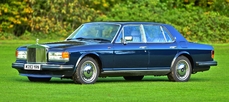Singer 1 1/2 Litre 1935
General description :
Vintage and Prestige are proud to offer this 1935 Singer Le Mans Special Speed Ruddy Singer Team Car For Sale.
Registration: BGK 20
Chassis no: 62677
Mileage shown: 321
Built for Trials and racing, the Singers were the most successful cars of the 1930’s in all national and international events in which sports cars featured. They won many coveted awards, in most cases the leading awards of the day.
Singer first competed at Le Mans in 1933 with a single car which became the first un-supercharged British car under 1000cc to qualify for the Rudge-Whittworth cup, this became the inspiration for the 2 seat Singer Le Mans which was launched at the end of September that year. The LeMans was continually developed by Singer and the 35 model had a 972cc engine with fully counterbalanced crankshaft and twin SU carburettors.
The Singer MSS D Team was the last team to be formed and was known as the Ruddy Team. The Ruddy team consisted of 3 cars; Dave Harris as the skipper in BGK 20, H W Johnson in Ruddy 2 and Bob Sandland in the third car.
They immediately made a very strong impression and started to win team and individual prizes together with other leading awards week after week.
BGK 20 represented the Singer Motor Car Club helping to win most of the team awards in all the trials and rallies of the period. BGK 20 was the 7thSpecial Speed model produced in the Autumn of 1934 when the Ruddy team was formed.
The Three works supported cars were all finished in Carnation Red livery and also known as the Singer Red Team. BGK 20 raced at Brooklands in the relay race of 1935, and also won many top awards as well as finishing 2ndin the 1935 Monte Carlo Rally.
BGK 20 is offered for sale in excellent condition, the Carnation red glistens in the sun, the paintwork matched with the red spoked wheels and high quality chromework makes this Singer Le Mans attractive from every angle.
There are twin spare wheels to the rear and a luggage rack on top of the LeMans fuel tank, allowing for plenty of luggage and fuel for a long journey.
The fluted red leather seats are also in excellent condition, much the same for the carpets and mohair hood.
The engine is smooth and strong, firing instantly the 997cc engine certainly has plenty of power, sitting behind the wheel you get a real understanding of how BGK 20 achieved runner up at the 1935 Monte Carlo rally.
A great opportunity to own an original Singer Le Man Special Speed team car, in our showroom and ready for viewing.
1935 Singer 1 1/2 Litre is listed for sale on ClassicDigest in Essex by Prestige House for Not priced.
Car Facts
Car type : Car Make : Singer Model : 1 1/2 Litre Engine size : 0.0 Model Year : 1935 Sub type : Convertible Location : Essex Vehicle Registration : Undefined
Not priced
Seller Information
Vintage & Prestige
Prestige House
+44(0)1375 379719, +44(0)7967 260673
Prestige House
+44(0)1375 379719, +44(0)7967 260673
Other cars listed for sale by this dealer
About Singer
Singer was a well-known name in both sewing machines and automobiles. The Singer brand expanded into car manufacturing in the early 20th century, producing cars that were notable for their quality, innovation, and engineering excellence. Here's a brief history and some key models of Singer cars:History of Singer Cars:
Foundation: The Singer Company began as a bicycle manufacturer in the 19th century and later diversified into sewing machines. In 1905, they ventured into car manufacturing, starting with their first prototype.
Early Years: Singer cars gained popularity for their reliability and performance. They were known for their innovative features, including advanced engine designs and sturdy chassis.
Key Models of Singer Cars:
Singer 10: Introduced in the 1910s, the Singer 10 was a small car available in various body styles. It was one of the early successful models for the company.
Singer Junior: The Junior series was introduced in the 1920s and continued into the 1930s. It was a range of small cars with different engine sizes and body styles, catering to various customers.
Singer Nine: The Singer Nine, launched in the mid-1930s, became a significant model for the company. It was known for its performance and handling, appealing to enthusiasts and drivers seeking a sporty driving experience.
Singer Le Mans: The Singer Le Mans was a sports car introduced in the late 1930s. It was named after the iconic 24 Hours of Le Mans endurance race and aimed to capture the spirit of racing.
Singer SM1500: Post-World War II, Singer introduced the SM1500, a larger car featuring a 1.5-liter engine. It was a step towards more modern designs and aimed at the family car market.
Legacy:
Singer cars were appreciated for their craftsmanship, engineering quality, and their emphasis on delivering a reliable driving experience. However, after World War II, the company faced challenges in keeping up with larger competitors, leading to financial difficulties.
In the late 1950s, Singer was acquired by the Rootes Group, a British automobile manufacturer, and the brand was gradually phased out. Despite its eventual decline, Singer cars left a legacy of well-built vehicles that were respected for their innovation and performance during their heyday. Today, vintage Singer cars are cherished by automotive enthusiasts and collectors for their historical significance and craftsmanship.




















